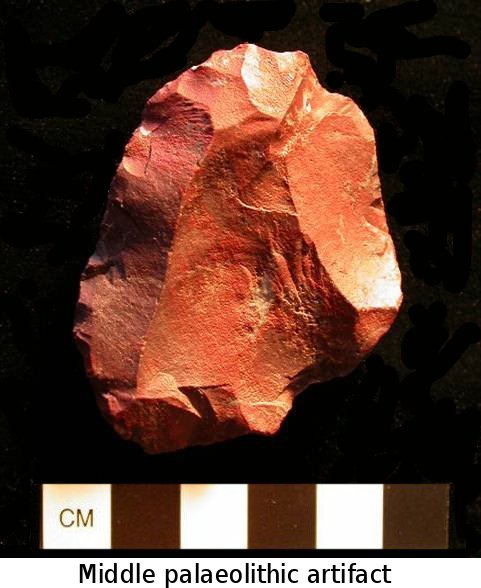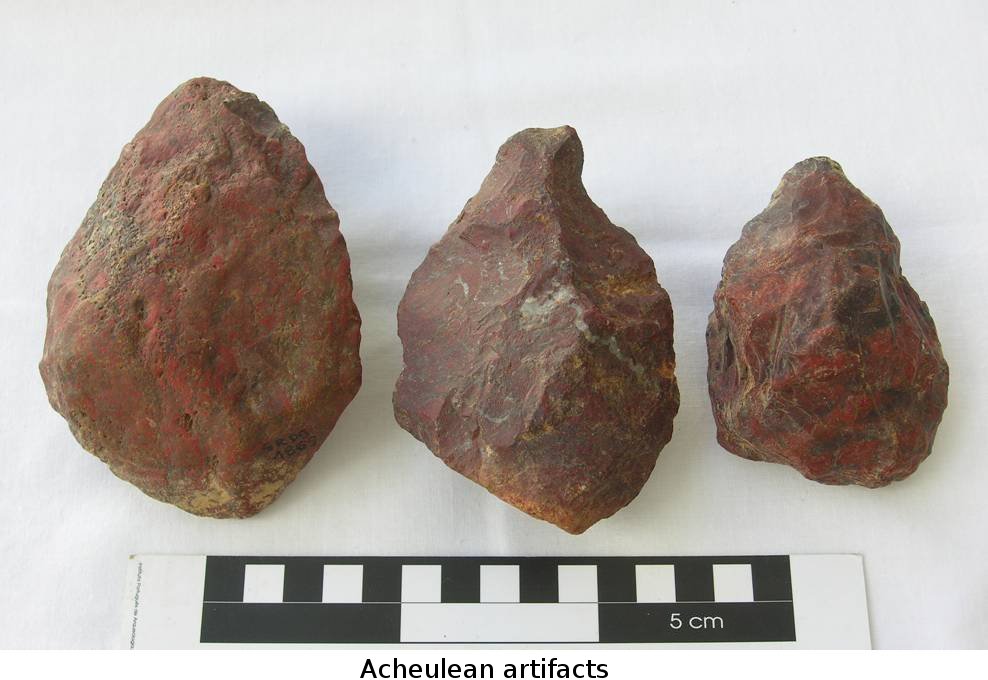Results
Surface (lithic) collection
 Prior to this survey, Palaeolithic discoveries along the Sado River and
its tributaries consisted mostly of isolated surface finds. By 2007,
the SRDS survey had sampled 107 locations. Twenty or so more locations
were sampled in 2008. Lithics were collected from 79 of the survey
locations and studied by Dr. Lilianne Meignen and Prof. Michael Bisson.
Of the 79 survey locations with lithics, 44 are isolated finds or small
lithic scatters (N < 10), 27 are localities with small
collections that are for the most part either undiagnostic or mixed, 8
are sites and localities containing large series and/or diagnostic
material. Two of the sites are attributed to the Lower Palaeolithic and
the other six are attributed to the Middle Palaeolithic.
Prior to this survey, Palaeolithic discoveries along the Sado River and
its tributaries consisted mostly of isolated surface finds. By 2007,
the SRDS survey had sampled 107 locations. Twenty or so more locations
were sampled in 2008. Lithics were collected from 79 of the survey
locations and studied by Dr. Lilianne Meignen and Prof. Michael Bisson.
Of the 79 survey locations with lithics, 44 are isolated finds or small
lithic scatters (N < 10), 27 are localities with small
collections that are for the most part either undiagnostic or mixed, 8
are sites and localities containing large series and/or diagnostic
material. Two of the sites are attributed to the Lower Palaeolithic and
the other six are attributed to the Middle Palaeolithic.
 Preliminary results (LM) indicate that the bulk of the
collection is composed of lithics that are not diagnostic of any
particular period of the Palaeolithic, e.g., radial cores on cobbles,
and quartz and jasper flakes. Diagnostic Middle Palaeolithic material
includes recurrent centripetal and preferential Levallois
cores and Levallois flakes, Discoidal cores and tools on Levallois
flakes. The number of retouched Middle Palaeolithic tools is small,
including notches and denticulate scrapers. Very few (N=6) pieces
attributable to an Upper Palaeolithic presence in the region have been
identifed (they include five small blade or microblade cores and one
blade fragment). Chalcolithic artefacts are rare. Two Neolithic sites
were identified on river terraces in the SE quadrant of the target
region in 2006.
Preliminary results (LM) indicate that the bulk of the
collection is composed of lithics that are not diagnostic of any
particular period of the Palaeolithic, e.g., radial cores on cobbles,
and quartz and jasper flakes. Diagnostic Middle Palaeolithic material
includes recurrent centripetal and preferential Levallois
cores and Levallois flakes, Discoidal cores and tools on Levallois
flakes. The number of retouched Middle Palaeolithic tools is small,
including notches and denticulate scrapers. Very few (N=6) pieces
attributable to an Upper Palaeolithic presence in the region have been
identifed (they include five small blade or microblade cores and one
blade fragment). Chalcolithic artefacts are rare. Two Neolithic sites
were identified on river terraces in the SE quadrant of the target
region in 2006.
All the material recovered on survey is being curated in the Museu Municipal de Aljustrel http://www.museualjustrel.com/
Lithic raw materials used during the Palaeolithic in the study region consist primarily of jasper (>65%) and quartz (>27%); quartzite and flint are extremely rare and other raw materials occur only sporadically.
Scatters, localities and sites
No significant Lower or Middle Palaeolithic sites were encountered in the northern sector of the drainage basin. In the southern sector, however, eight sites or localities were identified.
 |  |
| SRDS Northern Region | SRDS Southern Region |
Palaeolithic sites and localities
- Mina do Paço is a Middle Palaeolithic knapping station located on a schist outcrop in the vicinity of a jasper seam.
- Moinhos I is a knapping station located near a jasper seam that has been mined intermittently since the 19th Century. Material includes diagnostic Middle Palaeolithic pieces as well as material of unknown age.
- Moinhos II is a discrete, Middle Paleolithic locality situated roughly 750 meters from Moinhos I.
- Vermelha is a probable Acheulean locality located on the banks of a tributary of the Canhestro river, in the vicinity of Lagoa Vermelha. The locality was originally flagged as a possible Palaeolithic site by N. Almeida during environmental impact surveys conducted in 2000.
- Cabeça do Marco is a probable Acheulean locality situated on the Upper Terrace of the Sado river near a mapped jasper outcrop.
- Brejo is a Middle Palaeolithic locality in the immediate vicinity of a jasper outcrop.
- Chacafre II is a Middle Palaeolithic locality situated on a small terrace on the right bank of the Barranco Chacafre, a tributary of the Sado.
- Gasparões is a probable Middle Palaeolithic locality, situated in the bed of a small soak, or lagõa, approximately 1.5 kilometers from the site of Mina do Paços.
Other localities and low density lithic scatters
In addition to the 8 sites and localities described above, a further 27 localities and lithic scatters containing more than 10 pieces, of which 6 are attributable to the Middle Palaeolithic (Alamo, Bonito, Corte Vincente Anes, Lentiscais, Pedras Serranas) were discovered. The remaining localities and lithic scatters contain non-diagnostic material (discoid cores, flakes) or a mix of Middle Palaeolithic diagnostics and material from other periods (including pottery). These scatters derive mostly from river terrace locations or lakebeds.
The data recovered from 2005-2008 are currently being analysed for initial publication.


